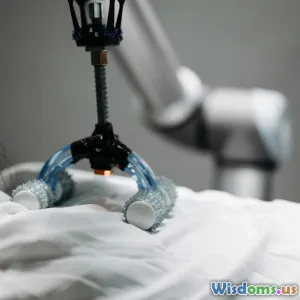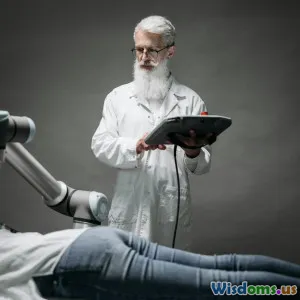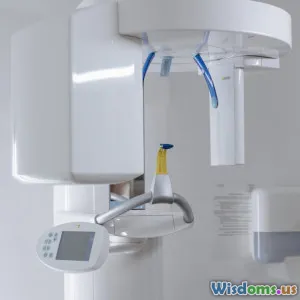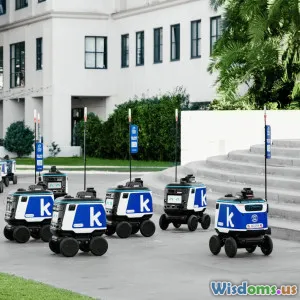
Top Industries Poised for Automation Disruption by 2030
7 min read Explore the top industries set for massive automation change by 2030, driven by AI and robotics innovation. (0 Reviews)
Top Industries Poised for Automation Disruption by 2030
Automation technology combined with artificial intelligence (AI) is driving one of the most transformative waves of change since the Industrial Revolution. By 2030, whole industries will undergo disruption—from the way they operate to how they deliver value. Businesses and workers alike face both unprecedented opportunity and challenge in this rapidly evolving landscape.
In this article, we'll explore the key industries on the frontline of automation disruption, backed by recent data, expert insights, and real-world examples. Understanding these shifts is crucial for preparing the workforce, policymakers, and enterprises for an automated future.
1. Manufacturing: The Robot Renaissance
Manufacturing has long been a bellwether for automation advancements, but the next decade promises an even deeper transformation. By combining robotics with AI-driven automation, manufacturers will see major efficiency gains and quality improvements.
- Smart Factories: The World Economic Forum predicts that 50% of manufacturing operations will be digitalized by 2025, integrating AI, IoT, and robotics to optimize workflows.
- Examples: Automotive giants like Tesla and Toyota are implementing collaborative robots (“cobots”) that work side-by-side with human workers, accelerating assembly lines without sacrificing safety.
- Data-Driven Decisions: AI models analyze large data sets from production lines to anticipate equipment failures, reducing downtime by up to 20% according to McKinsey & Company.
Impact: Routine, repetitive tasks will see the deepest automation, pushing the workforce towards higher-skilled roles such as robot maintenance, programming, and system integration.
2. Healthcare: AI Enhancing Diagnostics and Care
Automation in healthcare might not look like hanging robotic arms; instead, it’s about AI augmenting clinical decisions, managing administrative tasks, and supporting patient care remotely.
- AI Diagnostics: Studies published in Nature Medicine show AI algorithms matching or surpassing radiologists in detecting diseases like cancer from imaging data.
- Telehealth & Virtual Assistants: Automation in patient scheduling, personalized health monitoring, and even virtual chatbot-driven triage reduces the burden on human providers.
- Hospital Automation: Robots used for disinfecting facilities and delivering supplies have been scaled dramatically during the COVID-19 pandemic, improving safety and logistics.
Example: The Mayo Clinic leverages AI-powered tools to improve diagnostic accuracy and patient monitoring, reducing errors and improving outcomes.
Impact: Automation will allow healthcare professionals to focus more on complex patient interactions while improving efficiency and lowering systemic costs.
3. Logistics and Supply Chain Management: Speeding Up the Flow
The global logistics industry is on the cusp of automation-led disruption, driven by the need for faster and more reliable deliveries in e-commerce and global trade.
- Autonomous Vehicles & Drones: By 2030, companies like Amazon and UPS are expected to heavily utilize drone delivery and autonomous trucks to reduce last-mile delivery bottlenecks.
- Warehouse Robotics: Automated inventory systems using AI-powered robots are already improving picking and packing accuracy by 50% or more.
- Predictive Analytics: AI enhances demand forecasting accuracy, minimizing inventory costs and preventing stockouts.
Example: Alibaba’s Cainiao smart logistics network utilizes AI and robotics at scale, enabling same-day delivery to millions across China.
Impact: Automation reshapes the logistics workforce, emphasizing technical oversight, robotics management, and AI analytics specialists.
4. Agriculture: Precision Farming Meets Automation
Globally, pressure on food production efficiency has become a catalyst for automation in agriculture.
- Autonomous Machinery: Self-driving tractors and harvesters equipped with AI are enabling precision agriculture to optimize yields and reduce chemical usage.
- Drones for Monitoring: Aerial drones collect real-time crop data to help farmers make informed decisions about irrigation and pest control.
- Robotic Harvesters: Startups such as FarmWise deploy robots capable of weeding and harvesting, improving productivity and limiting manual labor.
Statistics: The global agricultural robots market is projected to exceed $11.6 billion by 2027 according to MarketsandMarkets.
Impact: Reduction of manual and seasonal labor, improved sustainability, and higher crop yields through data-driven insights.
5. Financial Services: AI-Driven Efficiency and Risk Reduction
Finance is embracing automation across multiple facets, from process automation to complex decision-making.
- Robotic Process Automation (RPA): Banks increasingly automate repetitive tasks like compliance checks, transaction processing, and customer inquiries, cutting costs and errors.
- Algorithmic Trading: Automated AI models execute trades at high speeds, leveraging vast datasets for optimal results.
- Risk Management: AI systems analyze fraud patterns and predict market risks with greater accuracy than traditional methods.
Example: JPMorgan Chase’s COiN platform automates legal contract reviews, reducing thousands of hours of manual work.
Impact: Enhanced efficiency and compliance, though it also prompts reskilling for finance professionals towards strategic and analytical roles.
Conclusion: Navigating an Automated Future
Automation, powered by AI, will redefine industries by 2030 in profound ways. While some jobs will transform or vanish, new opportunities will emerge for workers equipped with digital and technical skills. Organizations must strategically invest in retraining, human-machine collaboration, and ethical AI deployment to fully realize automation’s potential.
As leaders and individuals prepare for this shift, foresight, adaptability, and continuous learning become indispensable. The industries leading automation disruption today hold clues for all sectors to thrive in tomorrow’s economy.
The journey to 2030 is not merely about machines replacing humans but about working smarter together.
Rate the Post
User Reviews
Popular Posts





















